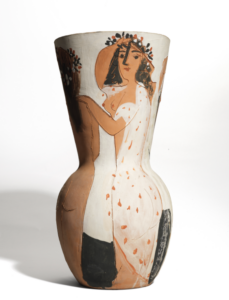Behind the Headlines
London Sale Sets World Record for Picasso Ceramics

June 21, 2013: A ceramic vase by Pablo Picasso, which has sold for a new world record price of almost £1 million for ceramics by the artist at a Christie’s sale (photo from Christies). PABLO PICASSO (Spanish, 1881-1973) Large Vase with Veiled Women (Grand Vase aux Femmes Voilées) May 1950 Red earthenware, incised, painted with engobe , russet, beige and black. Unique artist’s copy. 64.1 x 31.5 x 32.5 cm (25.25 x 12.4 x 12.8 inches) Unsigned. Dated inside vase: “VAl lAURIS, MAI 50”; Stamped inside vase below rim: “MADOURA PLEIN FEU” and “EMPREINTE DE PICASSO” partially effaced with white engobe; beside it an incised “1” inside a stamped circle. Have you ever wondered about the story behind the headlines, when record prices are achieved at auction by rare artworks? Here is an appraisal story about a ceramic vase by Pablo Picasso and its journey from a private Toronto home to the auction house floor in London. It illustrates the important role that appraisal services can play in both estimating value and establishing value in the appropriate marketplaces. This story begins in 1946, when Picasso accepted a chance invitation to visit and work at the Madoura Pottery studio in the village of Vallauris, on the French coast above Antibes. The clay was a good match for Picasso’s fertile imagination: malleable and capable of endless invention and improvisation. He returned every winter for the next 24 years, establishing an annual collaboration with the workshop’s owners, Georges and Suzanne Ramié. Over this period the artist produced more than 633 edited ceramic works, totalling an astounding 4,000 individual pieces including plates, bowls, vases and pitchers. In the first half of 1950, he created an important group of three large vases, produced by the workshop in editions of 25. Two of these versions (Ramié catalogue 115 & 116) develop a theme familiar since antiquity of linked female nudes whose forms mimic the shape of the vessel. In Picasso’s design for the Grand Vase with Veiled Women, the figures’ wide shoulders taper through the neck of the vase to narrow waists, under which their hips swell along with the body of the vase. This mirroring of forms is very successfully achieved with spare and elegant incised drawing, over which two differing versions of veiled ‘antique’ costumes were painted.
The Toronto vase, dated MAI 1950 inside the rim, appears to have held special importance in the artist’s own estimation, since he arranged to have it prominently featured and extensively reproduced in the deluxe art journal Verve (above) in 1951, and again in Sabartès and Boek’s book Picasso (1955) as a representative example of his work in ceramics. It appears in the photographs of Picasso at Vallauris that Yousef Karsh shot in 1954. Clearly, Picasso was satisfied with the result, as he kept this vase in his own collection and allowed it to be widely publicized so early. The vase remained in his possession until his death, after which it passed to his granddaughter Marina. It was subsequently sold by Picasso’s dealer in New York. Fast-forward to 2012, when the family in Toronto who have inherited the vase wonder if it has become too expensive to display in their home, and decide to have it appraised. They know that the international auction house Christie’s have just concluded the sale of the Madoura Collection in London – the largest collection of Picasso ceramics ever to be offered for sale, representing the now shuttered Madoura workshop’s entire inventory. During this marathon two-day session, 543 Lots of Picasso’s edited ceramics went under the hammer, with 100 % sold and four new records set. The record-breaking works include a version of Grand Vase aux Femmes voilées (Lot 39, Ramié 116, the workshop’s example of the edition of 25 stamped E.E. for “Exemplaire Editeur”) that is very similar to their own vase. Madoura’s version sells for the equivalent of $1,145,407 USD including premium at Christie’s, more than ten times the pre-sale estimate. For the appraiser, Lot 39 from the Madoura sale represents an obvious, direct comparable. Yet close inspection shows a number of anomalies. The painted decorations on the Toronto vase do not correspond exactly to either of the edited versions 115 or 116 produced by the Madoura workshop, or to the examples sold by Christie’s. Some detailed research into Picasso’s working methods within the flow of production at the workshop indicates the reason why. This vase is an independent version of the design painted by Picasso himself, very likely created from one of the press moulds for Ramié 115 as an experimental idea for 116, or during the production of Ramié 116. In either case the Toronto vase is extremely rare, because virtually all of the edited ceramics the artist produced were hand-painted by other artisans in the workshop using press moulds taken from Picasso’s original design (his ‘artist’s copy’) as their model. They are, in fact, genuine replicas of Picasso’s design authorized by the artist but created by others. In the Toronto vase we have the original template created by Picasso, a variant of Ramié 116 that was never carried through as an edition, making it a unique, original work by the artist’s own hand. None of the unique ceramic pieces created by Picasso at Madoura were catalogued, thus the exact number and whereabouts of such works is difficult to determine. There appear to be only a handful of these ‘artist’s copies’ worldwide, and most of those are in museum collections. The only other known unique artist’s copy of Ramié 116 was gifted by Picasso (and signed by him inside the rim) to the Museo Internazionale della Ceramiche in Faenza, Italy. Once properly identified, it became clear that the rarity of the Toronto vase alone elevates its value substantially. As a unique, original work, prominently featured in the early literature and with impeccable provenance, its estimated value exceeds the achieved values of all known comparables, including the works featured in the Madoura Sale. Faced with this news, the owner now decides to become a vendor, and the purpose of the appraisal assignment shifts to a market value assessment. The appraisal process now provides the client with the knowledge of value required to operate confidently in the marketplace, and ultimately leads to a successful negotiation with Christie’s and a new world record at auction for a Picasso ceramic work – just shy of a million Pounds. An example of how appraisers can offer services that range beyond estimating value – they can arm clients with knowledge about the worth of items of personal property that empowers them to realize their full value. Ken Forsyth, ISA AM Accredited
forsythfineart@sympatico.ca


